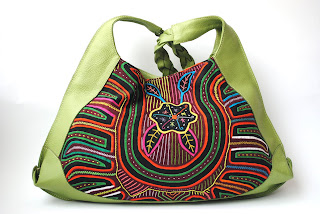




Original handmade, ethically produced, Colombian inspired designs. Koloni: supports local artistic communities and artisans; Engages in ethical trading and community development; Creates hand-made designs that are a departure from mass production and are an expression of creativity and individuality. Pieces are inspired by nature and indigenous culture.
Although I am half Colombian (my mother is Colombian), I didn't go there myself until 2008. I soon fell in love with the culture and variety of traditions. When I bought my first mola piece and filigree earrings, I immediately thought it is a shame that these aren’t available in the UK; so different and beautiful with artisans that are so meticulous but work in such troubled environments.
I studied BA Art History and MA Arts Management and it is as unique works of art that I share Koloni craft with you. Designs made with great love and respect for the traditions that they were inspired by and for the hands of skilled artisans that need to be appreciated and rewarded.
CONTACT ME
Jennifer@koloniaccessories.com
Blackberry Pin 27B7CA9
Skype Jengracep
In the island of Almira with kuna woman and in the remote town of Mompox. Both only possible to reach by water.



KOLONI MOLA COLLECTION
In today’s market, KOLONI provides a unique and exciting way to accent contemporary styles, whilst striving to honour Kuna creativity. Skilled leather craftsmen have integrated mola into daily accessories from western fashion. The craft of creating leather goods in Colombia, is world renowned and KOLONI supports independent leather smiths.
When you buy a KOLONI mola product, money goes to supporting the indigenous tradition.
mola makers
A traditional family where by the woman makes mola and the man deals with the agriculture and helps sell her mola designs.
wife dressed in traditional mola outfit and her husband models her innovative designs




TRADITIONAL MOLA
Molas are often sold in pairs, traditionally the front and back of the Kuna blouse. The two molas are usually two variations on a theme.
WHAT TO DO WITH MOLA?
Some people collect them like stamps or frame them as wall hangings. Others, make quilts, shirts, and other useful items such as tablecloths and bedspreads.
KOLONI
has incorporated mola designs into a range of accessories. Mola accentuates high quality Colombian leather bags and shoes, offering vibrant colours and unique designs.

WHERE DO THEY LIVE?
The kuna Indian culture of the Archipelago islands of San Blas, off the coast of Colombia and Panama, has continued for thousands of years and has changed little to this day.
Mola is an important symbol of Kuna culture. And the word ‘Mola’ means clothing in the Kuna language.
Mola is of such importance to the Kuna people that a rebellion was initiated when the government tried to prevent kuna women from wearing their traditional mola outfits and ultimately led to the independent status of the islands and legal recognition of their right to govern their territory autonomously.
CREATIVITY
The Kuna indians are very creative and have been described as the most striking and colourful among indigenous american communities. Mola has also been recognised in many anthropological and sociological museum collections.
KUNA WOMEN
It is a matriarchal culture where woman own property and choose who to marry. Women are the creative force and make mola that they wear and sell, and is today, the main source of income for the kuna people.
The ability to make an outstanding mola is a source of status among Kuna women.
Island tribal life
In the Islands of San Blas life goes on much as it did when Columbus sailed into the Bocas del Toro area 486 years ago, retaining many tribal customs and ceremonies.
PROTECTION OF SACRED GIANT TURTLES
One tradition includes the sacred protection of the giant turtles that lay their eggs on the shores of the Kuna beaches.
TRADITION OF ANIMALS AND NATURE
Mola designs are influenced by sea life; turtles and fish are a frequent motif.

WHAT IS MOLA?
MOLA is the name given to the intricate construction of layering solid coloured cloth in designs drawn from nature and everyday life. The patterns are cut for each element of the design and then every edge is folded and sewn into place by hand.
EACH MOLA IS A ONE OF A KIND ETHNIC DESIGN
WHO MAKES MOLA?
Mola forms part of the traditional costume of a Kuna woman, two mola panels being incorporated as front and back panels in a blouse.
WHY DO THEY MAKE IT?
Mola originated with the tradition of Kuna women painting their bodies with geometrical designs, using available natural colours; in later years these same designs were woven in cotton, and later still, sewn using cloth bought from the European settlers.
MAKING MOLA
It can take between 2 weeks and 6 months to make each unique mola. Designs are either geometic abstraction or naturalistic subject matters that have little concern with realism. The women spend every free moment sewing and they usually have several pieces of needlework going at one time.